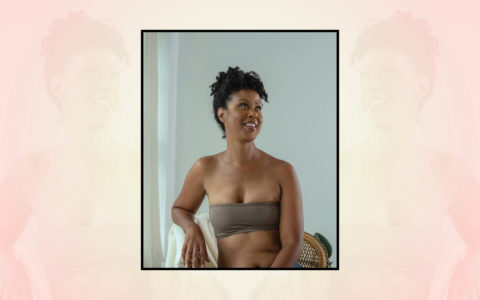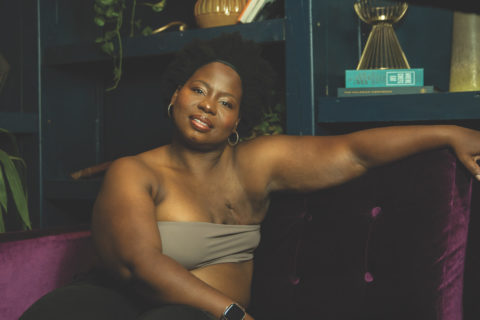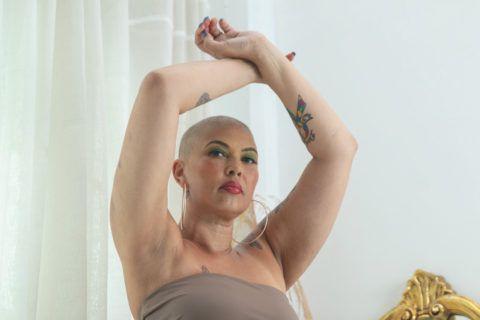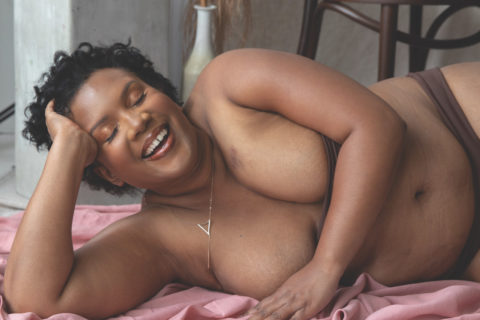“I Wanted People to Know What Scars Looked Like on Black and Brown Skin”
Meet Michelle Audoin, a Canadian breast cancer survivor who started a campaign for Black women affected by the disease.

When Michelle Audoin was diagnosed with breast cancer in 2017 and decided to undergo a double mastectomy that same year, she couldn’t help but wonder what she’d look like when it was all said and done, especially with the knowledge that darker skin is more susceptible to forming raised keloid scars. “That was a big concern for me. I wanted to see what reconstructive scars looked like on Black women,” she shares. But as Michelle looked through breast cancer materials provided to her and asked her health care team questions to help her prepare for surgery, she immediately found that the mainstream images and stories of patients only focused on one demographic’s experience of the disease, drowning out her own lived reality as a woman of colour.
Michelle underwent her mastectomy without a clear picture of what to expect, an incredibly frustrating and dark experience that eventually pushed the mother to team up with Canadian charity Rethink Breast Cancer this year to create a tangible resource that spoke to Black bodies. Uncovered: A Breast Recognition Project is a digital flip-book that sees eight Black Canadian women baring their physical and emotional scars of breast cancer in the hopes of helping others come to terms with their surgeries and spark a much-needed conversation around Black representation within the breast cancer community. Here, Michelle tells FASHION about her passion project.
On body image after her mastectomy:
“I was not prepared for the scars and the shape of my reconstructed breasts. I started looking at my body in sections — from above my chest and below the chest — avoiding looking at the reconstructed part because it felt like something foreign. Not having images of what other women of colour look like — not being able to have that conversation with my care team and see those images to help me process it — removes you even more from your own body. I felt cheated out of my body because of cancer. Accepting my body is still a work in progress post mastectomy. I still haven’t made a final decision on what I want my reconstructed breasts to look like because, again, those type of images are still not out there.”

On the motivation behind her powerful breast cancer project:
“To process my emotions and frustrations, I would journal about my feelings and what was bothering me. Then one night I was re-reading my notes and I just wished things had been different — I wished I had those images. I wished people had heard my story, my pain, my grief and my frustration. Then I thought: If I turned this all into some type of breast recognition project, what would I want people to know about my breasts and my story? A very traumatizing part at the time for me was that I was still nursing my son to sleep, and to be told that you have breast cancer, that you’re going to have surgery, that you’re going to have to wean your child off feeding immediately — I was loosing that bond, that relationship, that moment with my child. I just felt like those kinds of stories were not being heard and acknowledged. So I just started writing ideas up of what I’d wanted to see out there: I wanted other people to see my scars and know what these scars looked like on Black and Brown skin. I wanted other women of colour’s stories to be heard.”

On partnering with Rethink Breast Cancer:
“At that time, Rethink was putting themselves out there in response to the Black Lives Matter movement, committing to do better and acknowledging how they’d fallen short of serving Black, Indigenous and people of colour communities. So I decided to I reach out to them and expressed my concerns and offloaded all of my frustrations about my cancer experience. It first started off with a few Zoom calls then I got an email saying, ‘Take a look at this. This is what we propose.’ It was really gratifying because it felt like Rethink heard my story, heard my vision and they weren’t trying to change it in any way. They went off in the background and took care of things, like putting a call-out through their network to find these seven courageous women.”

On representation behind the scenes during the Uncovered photo shoot:
“I wanted to have a Black photographer, a Black makeup artist and a Black hairstylist behind the scenes because these are the types of things that are often overlooked within the Breast cancer experience. Like if you have Black textured hair and walk into a Look Good Feel Better workshop in the hospital, there’s a lack of wig options. Basically there are wigs that suit Caucasian hair types or you can wear a toque or head scarf. There’s a lot of identify wrapped up in women’s hair, so to loose your hair and not have any options to feel good about yourself is hard. The same goes for makeup. You’ll see from the stories shared in the Uncovered: A Breast Recognition Project that that was an experience a lot of the women had: Not being able to have people make them feel beautiful through proper makeup treatments like their white counterparts can easily access. So it became really important for me to have that representation on set to uplift these women who are going through such a vulnerable experience.”

On the cathartic experience of the photo shoot and the breast cancer community’s response:
“I was the first one to be photographed and when I walked in, I thought was going to be sick. I wondered, ‘What did I get myself into?’ But after I was made to feel beautiful by having someone play with my hair and makeup, I felt more empowered in my own skin. And as I watched all the other women come on set, I found that they all kind of walked in like me: unsure, reserved, nervous. But then to see them get their hair and makeup done and then get photographed, their expressions as they walked off set were like night and day. They too felt empowered, beautiful — they looked overjoyed.

The response from the breast cancer community on social media has been really empowering as well and speaks to the lack of representation and the need for a resource like this in the community. Even my plastic surgeon reached out and acknowledged that, yes, this is a big hole in the community and we need more representation. That was a really solidifying moment for me.”
On her long-term hopes for Uncovered: A Breast Recognition Project:
“I want it to reach far and wide. I want it to spark conversations in cancer care centres with the plastic surgeons, nurse practitioners and the cancer care community agencies. I think it’s shinning a light on the current Eurocentric face of breast cancer and that the experiences of women of colour are very different from their white counterparts. My hope is that, moving forward, cancer care centres will be able to give this resource to their patients of colour so that they feel less alone in the experience.”
The entire Uncovered: A Breast Recognition Project resource is available on the Rethink Breast Cancer website. For more stories like this one, read our previous My Story columns.







